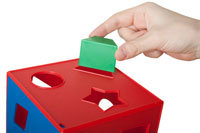- About Ramapo
- Academics
- Admissions & Aid
- Student Life
- Athletics
- Alumni
- Arts & Community
- Quick Links
- Apply
- Visit
- Give
Our Research
Current research in the lab asks:
- Do children know which actions their bodies and objects can do?
- What information do children use to help make their decisions?
- What role do caregivers play in children’s decisions?
 In a typical study session, children are presented with situations that may require crawling, reaching, grasping, and fitting. Children’s decisions are observed and compared to actual possibilities for action. Learning to reach and grasp is a complex problem because children must have enough strength to get their arms up and must learn to guide their hands to a target object or surface. Goal-directed reaching and grasping is especially difficult because it requires multiple skills. Children must obtain perceptual information about the location of the object relative to the location of the hand, as well as position the hand with regard to object properties. However, people can differentiate their grip size according to object size and shape by using one hand to grasp small objects, and two hands to grasp large ones. They can also use only their thumb, index, and middle fingers to grasp small object and the entire hand to grasp large objects.
In a typical study session, children are presented with situations that may require crawling, reaching, grasping, and fitting. Children’s decisions are observed and compared to actual possibilities for action. Learning to reach and grasp is a complex problem because children must have enough strength to get their arms up and must learn to guide their hands to a target object or surface. Goal-directed reaching and grasping is especially difficult because it requires multiple skills. Children must obtain perceptual information about the location of the object relative to the location of the hand, as well as position the hand with regard to object properties. However, people can differentiate their grip size according to object size and shape by using one hand to grasp small objects, and two hands to grasp large ones. They can also use only their thumb, index, and middle fingers to grasp small object and the entire hand to grasp large objects.
We use a variety of experimental methods (parental reports, psychophysics, questionnaires) and present children with many trials to gather data about how children learn to make decisions. Some of our studies examine how children cope with fitting tasks with the aim of understanding the exploratory behaviors that children perform when deciding whether to fit objects through small and large openings. Fitting is a multi-step process involving prospective planning, decision-making, and linking several small routines into a unified action. Success involves choosing the correct object, placing it over the hole, aligning it to the orientation of the hole, and finally firmly pushing it forward. Previous research shows that adults are accurate at deciding whether their hands and whole bodies fit through openings (Ishak, Adolph, & Lin 2008; Warren & Whang, 1987). For infants and children, however, the task may be especially challenging because they undergo rapid changes in their bodies and abilities. Fitting objects into openings demands an even higher level of accuracy than fitting the body because most objects are not deformable. The body can be compressed and contorted to approximate the size of the opening but a square wooden block cannot.
Studies last between 45 and 60 minutes and can be scheduled for day, evening, or weekend sessions. The procedure for the laboratory session is safe and simple without any risks beyond those of everyday life. Most participants appear to enjoy the experience. Any information collected is kept strictly confidential.
We are currently conducting studies with infants and children between 1 and 8 years of age. With your help, we hope to learn more about the factors that affect human learning and development. We would love for your child to participate in our research.
Copyright ©2025 Ramapo College Of New Jersey. Statements And Policies. Contact Webmaster.
